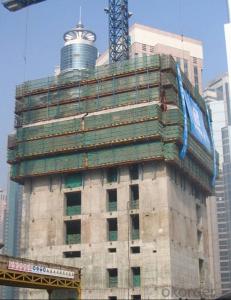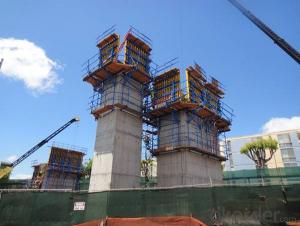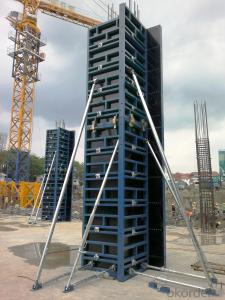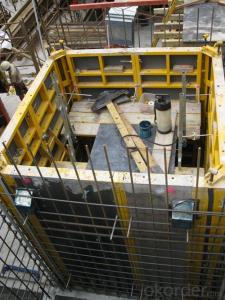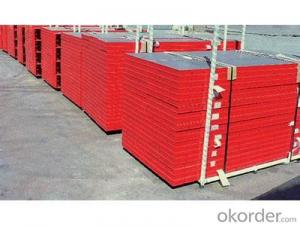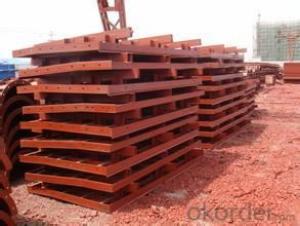Scaffolding Jack Base Formwork Scaffolding Equipment Names with New Design
- Loading Port:
- Tianjin
- Payment Terms:
- TT OR LC
- Min Order Qty:
- 8000 set
- Supply Capability:
- 50000 set/month
OKorder Service Pledge
OKorder Financial Service
You Might Also Like
Scaffolding Jack Base Formwork Scaffolding Equipment Names with New Design
Scaffolding For High-Rise Buildings Formwork Scaffolding Truss High Quality
Frame Scaffolding Systems Formwork Bs Standard Scaffolding Tube With Low Price
Developing with new technology materials, steel formworks is no longer a must in construction concrete process. More and more buildings are established with plastic formworks. And workers love this new formworks much more.
The advantages of plastic formworks:
Scaffolding Jack Base Formwork Scaffolding Equipment Names with New Design
1.First of all--light
Yes it is the first advantage of plastic formwork. It wins the great praise of both contractors and workers.
The biggest panel is 120×1500px,weights 10.5kg only. It can be lift and set up by one person easily, which means there is no need for cranes on site.Saves a lot of cost and time.
2.Easy set up
Different size of panels can firmly locked by simply turn the special handles to 90 degree. The Panels has rib on the back, which makes the system need not traditional wood blocks and nails. The panels have holes to fit tie rod, guarantee the strength of the whole system.
3.Modularity
Modular formworks composed by different size of panels,the main item is 120×1500px panel,which is used for the large area of walls and slabs. There are also small size of panels like 10×1500px,20×1500pxcm,25×1500px,inner corner 20×20×1500px and outer corner 10×5×1500px.Due to the variety of panel size, the system can form almost all size walls 120×1500px panel of multiply by 125px. The material of modular formwork is PC-ABS mixed with special glass fibers which enable panels to hold high pressures.
4.Strength
The handles are made by high strength Nilon, each panel locked by at least 4 handles, which makes the whole system strong enough to pour 1000px walls.
5.Environment friendly
The system needs no cut and nail due to the variety size. Also it needs nearly no wood. The material can be recycled after broken, so it will not pollute the environment.
6.Consequent
Concrete does not stick to plastic formwork, thus the panels need no oil before using, and can be cleaned simply by water. The surface of the wall which build by modular formwork is smooth and without rework.
Scaffolding Jack Base Formwork Scaffolding Equipment Names with New Design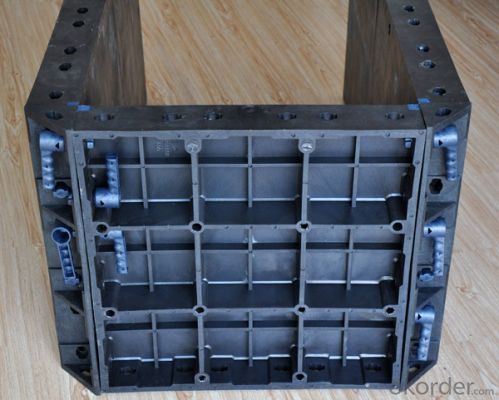
Scaffolding Jack Base Formwork Scaffolding Equipment Names with New Design
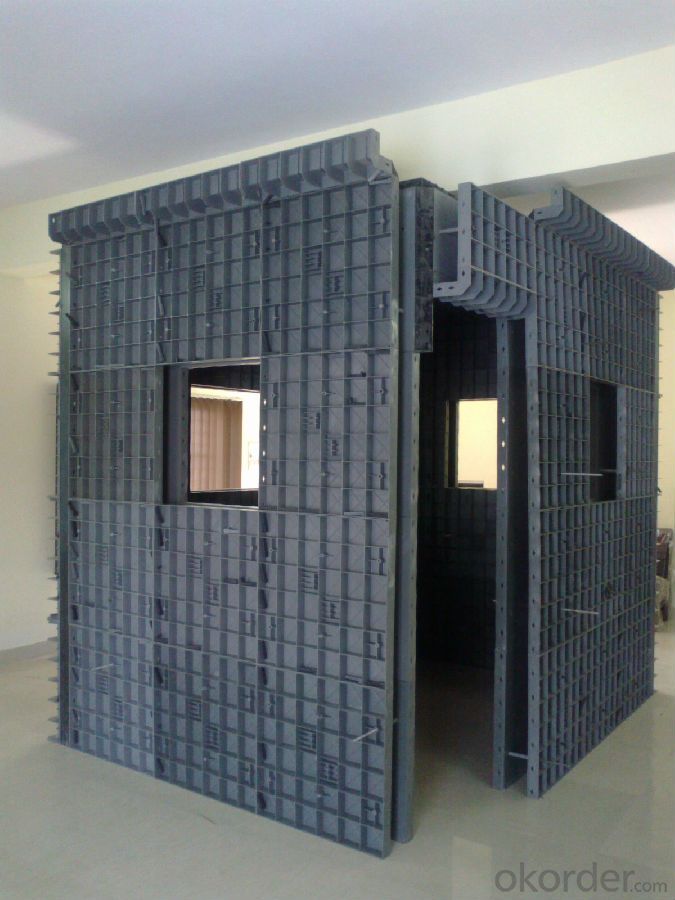
Scaffolding Jack Base Formwork Scaffolding Equipment Names with New Design

Advantage
* Good loading capacity
* Easy to assemble and dismantle
* Stable and durable thanks to its structual design & automatic welding quality
* Customized solution helps you work safe, save cost and convenient
* Excellent quality for formwork & scaffolding with wide choices
Packing
in bulk or in bundle, or as requested
Shipping
15-20 Days.
Normally small orders, it needs just 15-20 business days to the port. For goods with stock, it would be even shoter.
Scaffolding Jack Base Formwork Scaffolding Equipment Names with New Design
Other scaffolding & formwork products:
(1) Scaffolding System:
Including Ringlock Scaffolding System and accessories; Cuplock Scaffolding System and accessories; Kwikstage Scaffolding System and accessories; Haki Scaffolding System and accessories;
(2) Scaffolding Frame & Accessories:
Including Walk Through Frame Scaffolding; Ladder Frame Scaffolding; Accessories; we also can make scaffolding according to your samples or drawings.
(3) Scaffolding Couplers/Clamps:
We can produce all kinds of forged and pressed couplers, including British type couplers, American type couplers, German type couplers, Italian type couplers ,fence couplers, BRC coplers and so on. We also can produce according to your drawings or samples.
(4) Formwork System Scaffolding & Accessories:
Light Duty Shoring prop and Heavy Duty Shoring Prop; Wing nuts and Tie rods; RASTO clamp and so on.
FAQ Scaffolding Jack Base Formwork Scaffolding Equipment Names with New Design
Why Us?
We are one of the Top 500 in the world, largest construction materials supplier in China. Also we are a state-owned company and respond to every customer with large and also small orders.
We own professional manufacturers with powerful producing capacity.
Extensive and comprehensive quality control system
Excellent products with competitive prices.
Efficient services in pre and after sale.
Full energy with affluent experience team.
- Q:How does steel frame formwork compare to fiberglass formwork?
- Both steel frame formwork and fiberglass formwork are popular choices for construction projects, but they differ in terms of material composition, durability, and cost. To begin with, steel frame formwork is composed of steel frames and plywood panels. This combination provides excellent strength and stability, making it suitable for heavy-duty applications. The steel frames are capable of withstanding heavy loads and provide exceptional support for concrete pouring. Moreover, the plywood panels can be used multiple times in various projects due to their high reusability. On the contrary, fiberglass formwork is constructed using reinforced fiberglass panels. This material is lightweight yet durable, which offers advantages in terms of easier handling and transportation. Additionally, the fiberglass panels display resistance to water, chemicals, and UV radiation, making them ideal for projects with specific requirements such as coastal areas or corrosive environments. In terms of durability, steel frame formwork is generally regarded as more resistant to wear and tear. Steel frames have a longer lifespan and can endure rough handling and extreme weather conditions. They are also less prone to deformation and can be easily repaired or modified if necessary. While fiberglass formwork is durable, it may be more susceptible to damage if mishandled or subjected to excessive force. However, both types of formwork can have extended lifespans with proper care and maintenance. Cost is another aspect to consider when comparing steel frame formwork to fiberglass formwork. Initially, steel frame formwork tends to be more expensive as it requires the purchase of steel frames and plywood panels. However, due to its high reusability, the overall cost per project may be lower in the long run. On the other hand, fiberglass formwork is cheaper upfront but may need to be replaced more frequently, resulting in higher overall costs over time. In conclusion, steel frame formwork and fiberglass formwork each have their own advantages and disadvantages. Steel frame formwork offers strength, stability, and durability, making it suitable for heavy-duty applications. On the other hand, fiberglass formwork is lightweight, resistant to environmental factors, and initially more cost-effective. Ultimately, the choice between the two will depend on the specific project requirements, budget constraints, and expected lifespan of the formwork.
- Q:How does steel frame formwork handle different types of concrete mixes?
- Steel frame formwork is highly versatile and capable of handling different types of concrete mixes effectively. Its robust and sturdy construction ensures it can withstand the pressure and weight of various concrete compositions, including high-strength mixes. The steel framework provides excellent support and stability during the pouring and curing process, ensuring the concrete retains its desired shape and strength. Furthermore, steel frame formwork offers flexibility in adjusting the formwork to accommodate different concrete mixes, allowing for precise construction and customization.
- Q:Can steel frame formwork be used in high-rise construction projects?
- Yes, steel frame formwork can be used in high-rise construction projects. Steel frame formwork is known for its durability and strength, making it suitable for supporting the weight of concrete in tall structures. It provides stability and ensures accurate and precise construction, which is crucial in high-rise buildings where safety and structural integrity are paramount. Additionally, steel frame formwork can be easily assembled and dismantled, allowing for efficient construction processes in such projects.
- Q:Can steel frame formwork be used with different types of concrete?
- Different types of concrete can be used with steel frame formwork. This versatile and flexible system can accommodate normal concrete, high-strength concrete, lightweight concrete, self-compacting concrete, and even special types like fiber-reinforced concrete. The durability and strength of steel formwork make it suitable for handling the pressures exerted by different types of concrete during pouring and curing. It can withstand the weight of the concrete and the vibration caused by compaction without deforming or failing. In addition, steel formwork can be easily adjusted and modified to fit various shapes and sizes of concrete structures. It allows for the creation of complex shapes and intricate designs, making it suitable for a wide range of construction projects. Overall, steel frame formwork is a reliable and efficient choice for different types of concrete. It provides the necessary support and stability during construction, ensuring high-quality and precise concrete structures.
- Q:How does steel frame formwork handle the construction of stairs and ramps?
- Steel frame formwork is an ideal choice for the construction of stairs and ramps due to its strength, durability, and flexibility. The steel frame formwork system consists of steel panels, props, and connectors, which can be easily assembled, adjusted, and dismantled according to the specific requirements of stairs and ramps. When constructing stairs, the steel frame formwork is designed to support the weight of workers and materials during the pouring and curing of concrete. The panels, which are made of high-quality steel, provide excellent structural stability, ensuring the safety and stability of the staircase. The formwork system can be customized to create different types of stairs, including straight, spiral, or curved designs. Similarly, when constructing ramps, steel frame formwork offers numerous advantages. Its adjustable props allow for the creation of ramps with varying heights and slopes, making it suitable for different applications such as car parks, pedestrian walkways, or wheelchair access ramps. The versatility of the system enables the construction of ramps with various configurations and dimensions. Additionally, the steel frame formwork system can be easily adapted to accommodate architectural features such as landings, handrails, and balustrades in the construction of stairs and ramps. This flexibility ensures that the final structure meets the desired design and functionality requirements. Overall, steel frame formwork simplifies and streamlines the construction process of stairs and ramps by providing a robust and versatile solution. Its strength, durability, and adaptability make it an excellent choice for creating safe and reliable access points in buildings and infrastructure projects.
- Q:Is steel frame formwork resistant to fire?
- Steel frame formwork is indeed fire resistant. Not only is steel a non-combustible material, but it also does not aid in the propagation or escalation of fires. Its melting point, which usually reaches approximately 1370 degrees Celsius, allows it to endure high temperatures without compromising its structural integrity. Hence, steel frame formwork proves to be a secure and dependable option for construction ventures that prioritize fire resistance. Moreover, steel's resilience and robustness guarantee that the formwork remains undamaged even in the most severe fire circumstances, offering additional safeguarding to the developing structure.
- Q:How does steel frame formwork affect the overall weight of a construction project?
- Steel frame formwork can have a significant impact on the overall weight of a construction project. Unlike traditional wooden formwork, steel frame formwork is much lighter and more compact. This reduction in weight not only makes it easier to transport and handle on-site but also reduces the overall dead load of the structure. As a result, steel frame formwork helps optimize the structural design, enhance the efficiency of construction processes, and potentially reduce costs.
- Q:Can steel frame formwork be used for high-temperature industrial structures?
- Yes, steel frame formwork can be used for high-temperature industrial structures. Steel is known for its high strength and durability, making it suitable for withstanding high temperatures. It has a high melting point, which allows it to maintain its structural integrity even in extreme heat conditions. Additionally, steel has excellent fire resistance properties, making it a safe choice for high-temperature environments. However, it is important to ensure that the steel frame formwork is properly designed and constructed to withstand the specific temperature requirements of the industrial structure. This may involve using heat-resistant coatings or insulation materials to protect the steel from excessive heat and prevent any potential damage.
- Q:How is steel frame formwork assembled?
- Construction projects commonly utilize steel frame formwork to create concrete walls, columns, beams, and slabs. The process of assembling steel frame formwork involves multiple steps. Firstly, the construction site must be prepared before the steel frame formwork is assembled. This involves tasks such as leveling the ground, removing debris, and implementing necessary safety measures. Next, the layout and dimensions of the concrete structure are marked on the ground or wall where the formwork will be installed. This step ensures accurate placement of the steel frames. Vertical supports are then erected to provide stability and strength to the formwork. These supports, typically made of steel or aluminum, are secured to the ground or wall using bolts or anchors. Horizontal beams are installed and connected to the vertical supports to create the frame structure. These beams are positioned according to the marked layout and secured in place using connectors or clamps. Following the installation of the frame structure, plywood panels are attached to the steel frame using screws or nails. These panels serve as the surface upon which the concrete will be poured and formed. The size and thickness of the plywood depend on the project's specific requirements. Reinforcement and bracing are added to the formwork to ensure stability during the concrete pouring process. This can include diagonal braces, tie rods, and cross beams that provide extra support and prevent movement or deformation. Once the steel frame formwork is assembled, it is thoroughly checked for any gaps, misalignments, or loose connections. Any issues are promptly rectified to ensure a tight and secure formwork structure. Any necessary adjustments or modifications are made at this stage. Overall, the assembly of steel frame formwork necessitates meticulous planning, precise measurements, and proper installation techniques. It is crucial to adhere to the manufacturer's instructions and comply with safety guidelines to ensure a successful and safe construction process.
- Q:How does steel frame formwork address issues of concrete cracking and spalling?
- Steel frame formwork addresses issues of concrete cracking and spalling in several ways. Firstly, steel frame formwork provides a rigid and stable structure to support the weight of the fresh concrete during the casting and curing process. This eliminates any movement or shifting of the formwork, which can lead to uneven concrete surfaces and potential cracking. Secondly, steel frame formwork allows for precise and accurate placement of reinforcement bars and ensures proper alignment. This helps to distribute the load evenly, reducing the chances of localized stress concentrations that can cause cracking or spalling. Additionally, steel frame formwork provides a smooth and uniform surface finish, reducing the likelihood of air voids or weak spots in the concrete. This helps to prevent moisture ingress and the subsequent freeze-thaw cycle that can cause spalling. Furthermore, steel frame formwork can be easily adjusted and modified to accommodate different shapes and sizes of concrete elements. This flexibility allows for the proper placement of additional reinforcement where required, further enhancing the structural integrity of the concrete and minimizing the risk of cracking or spalling. Overall, the use of steel frame formwork in concrete construction helps to address issues of concrete cracking and spalling by providing a stable, accurate, and well-supported framework for the concrete, resulting in a durable and high-quality finished product.
1. Manufacturer Overview |
|
|---|---|
| Location | |
| Year Established | |
| Annual Output Value | |
| Main Markets | |
| Company Certifications | |
2. Manufacturer Certificates |
|
|---|---|
| a) Certification Name | |
| Range | |
| Reference | |
| Validity Period | |
3. Manufacturer Capability |
|
|---|---|
| a)Trade Capacity | |
| Nearest Port | |
| Export Percentage | |
| No.of Employees in Trade Department | |
| Language Spoken: | |
| b)Factory Information | |
| Factory Size: | |
| No. of Production Lines | |
| Contract Manufacturing | |
| Product Price Range | |
Send your message to us
Scaffolding Jack Base Formwork Scaffolding Equipment Names with New Design
- Loading Port:
- Tianjin
- Payment Terms:
- TT OR LC
- Min Order Qty:
- 8000 set
- Supply Capability:
- 50000 set/month
OKorder Service Pledge
OKorder Financial Service
Similar products
New products
Hot products
Hot Searches
Related keywords
